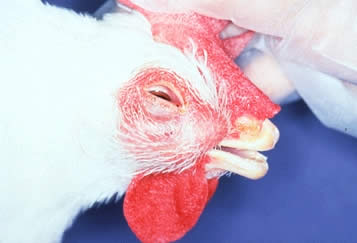Infectious Coryza
Infectious Coryza
Infectious coryza is a contagious bacterial respiratory infection of chickens. While there are reports of a similar disease in other birds such as pheasants and guinea fowl, there is considerable doubt if these non-chicken cases are associated with the same aetiological agent. The disease occurs most often in adult birds. Infection can spread slowly, with chronic disease affecting only a small number of birds, or rapidly, with a higher percentage of birds being affected. Clinical signs include swelling around the face and wattles, watery or pus-like discharge from the eyes and nostrils, difficulty breathing, sneezing, loss of appetite, weight loss and a drop in egg production.

Swollen sinuses from Infectious Coryza Source: The Merck Veterinary Manual
What causes infectious coryza?
Infectious coryza is caused by the bacterium Avibacterium paragallinarum. Earlier names for this organism, including Haemophilus paragallinarum and Haemophilus gallinarum should no longer be used. The bacterium is spread through contact with infected birds or exudates. Recovered birds remain carriers of the bacteria for long periods and as such, once a flock is infected all birds must be considered as carriers. Birds can be more susceptible if already infected with other respiratory viral or bacterial infections.
Prevention and treatment
Infectious coryza can be treated with a number of antibiotics and vaccines are used to prevent infection in high incidence areas. However, control of the disease requires good husbandry practices. Prevention is best achieved using biosecurity principles based on an all-in/all-out replacement policy and ensuring replacement birds are not infected. If infection occurs, complete depopulation followed by thorough cleaning/disinfecting is the only means for eliminating the disease. The bacterium survives 2-3 days outside the bird but is easily killed by heat, drying and disinfectants.

